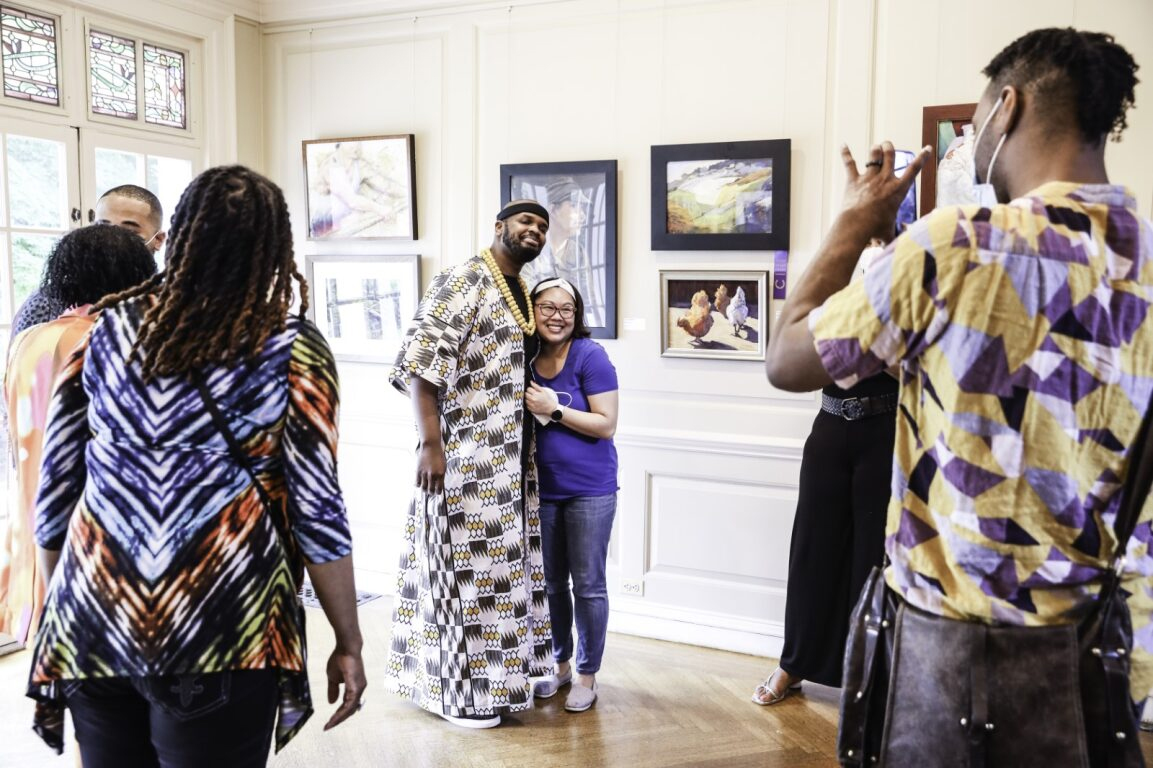ARTISTS INSPIRING ARTISTS
Exploring the collaborative growth between Arts and Social Justice Fellowship mentors and mentees.
By Jessica Gregg
The distinct and transformative nature of Strathmore’s Arts and Social Justice Fellowship (ASJF), with core partner Woolly Mammoth Theatre Company, is what attracted mentors Alexandra N. Sherman, Rashad Ali Muhammad, and Emon Surakitkoson to the program—a concept each artist wished had existed when they were students.
Launched in 2022, ASJF pairs high school artists from Maryland, Virginia, and Washington, DC, with working artists who serve as mentors. These professionals work alongside program facilitators Tavish Forsyth and Blue Cavell-Allette to support the students in creating projects at the intersection of arts and social change. Having participated in solo and group exhibitions at Strathmore and other galleries, Sherman, Muhammad, and Surakitkoson had the practical experience that mentors need.
In the wake of the pandemic, political discord, global environmental struggles, and escalating oppression, Sherman sees Strathmore’s fellowship as a source of light during these dark times, as art always does. “It just feels like an injection of hope to have a program like this,” says Sherman, a painter and mixed media artist based in Round Hill, Virginia, who was excited to mentor two young visual artists.
Fellows receive a stipend to support their projects however they wish, an important provision for young artists who may lack financial resources, explains Sherman. It’s one of the ways she sees the program conveying an important message to its young participants: “We want to hear your voice.”
One of Sherman’s mentees, Jada King, created a sculpture and presentation about workplace pay inequality, and the other, Myla Leung, used multimedia, collage, and decoupage to address plastic pollution. Knowing that they might not have fully developed their own practices, Sherman encouraged them to start with sketching and writing. Later, she provided them with resources to complete their projects, including supply recommendations and video tutorials for their mediums.
At the end of the fellowship, which also prioritizes community-building and peer-to-peer learning, the student artists held a showcase of their work at Woolly Mammoth. “I was just blown away by the passion, energy, and dedication of these young people,” Sherman says.
“It was really impressive how professional and motivated they were,” agrees Muhammad. “The mentees were articulate and confident in their bodies as they shared what inspired them. I left rejuvenated and inspired to create new art.”
The opportunity to make a difference and the social justice component drew him to the program. Muhammad, a mixed media collagist, focuses his work on addressing diverse groups of people about shared human experiences. He sees ASJF providing similar permission to explore humanity, which is important for teenagers transitioning into adulthood and for young artists honing their craft.
As a mentor, he answered technical questions about the ways to use different media for various effects, but most of his role involved affirming the visions of these rising artists.
Surakitkoson adopted a similar mentoring style. Much of her advice centered on the empowerment and encouragement she believes young creatives need to thrive in a career that often feels unstructured.
“Everyone needs to find their own voice,” she told her mentees. “What kind of artist do you want to be, and what do you want to say?”
She also instructed her mentees on discovering opportunities, such as approaching small businesses to showcase their art, and the importance of tuning out distractions. “When I create, I only have myself to impress,” she says.
Surakitkoson’s black-and-white abstract paintings are designed to be timeless, inviting viewers to engage with her work no matter where they are. However, as she mentored her two students, she found herself considering adding color to her work—an idea that thrilled her yet made her anxious. “I didn’t want it to look like a rainbow,” she admits. Instead, she sought to use color to add depth and wonder to her pieces.
Recalling the advice she gave her mentees, “You can do whatever you want,” she began experimenting with color in her paintings.
“I was speaking to them, but they also taught me,” Surakitkoson reflects. “[My mentees] gave me as much as I gave to them.”
Don’t miss the Class of ’24 ASJF Showcase!
Sat, June 22, 1pm at AMP
The Arts and Social Justice Fellowship is made possible with generous support from Dr. Deborah M. Smith and the Dr. Allen A.B. Herman Fund.
Strathmore is deeply grateful to the many individuals, corporations, and foundations who provide vital funding for our Bloom programs, which includes the Arts and Social Justice Fellowship, ensuring access for all.


